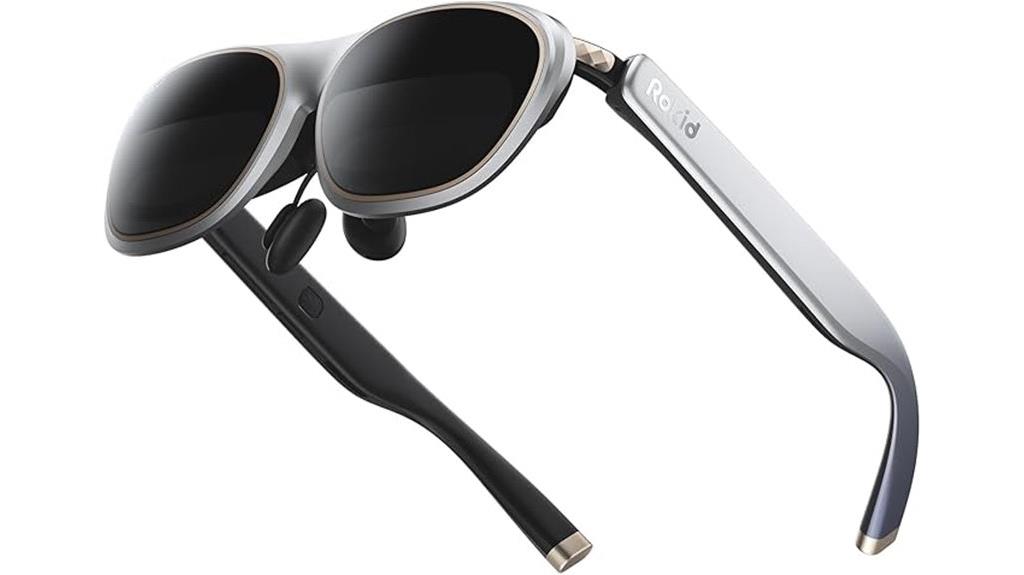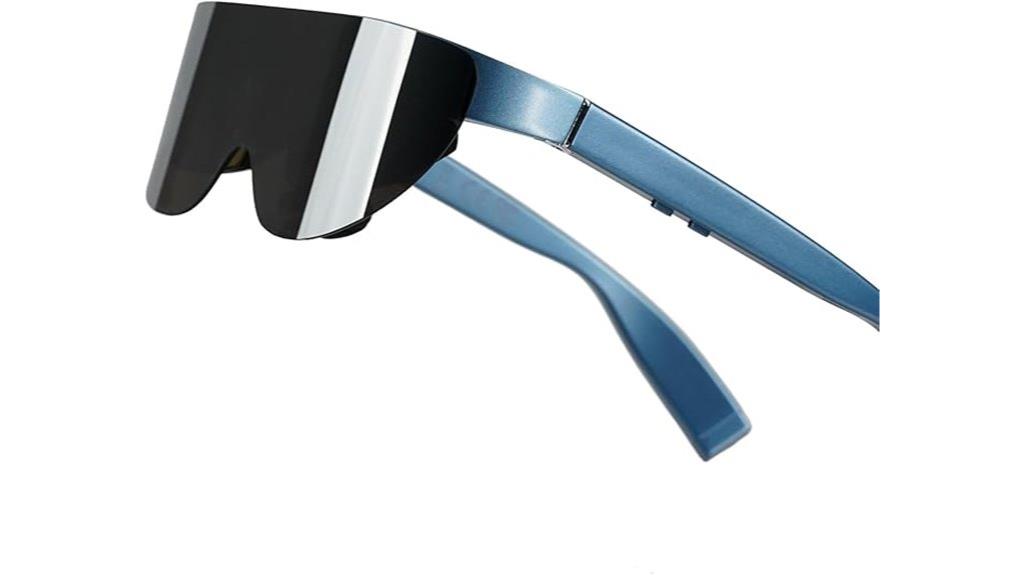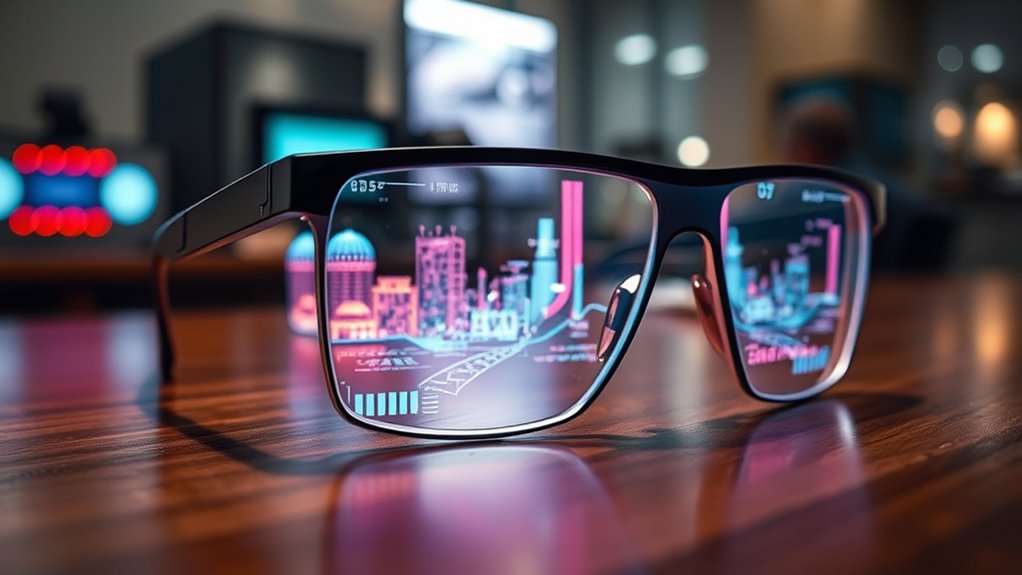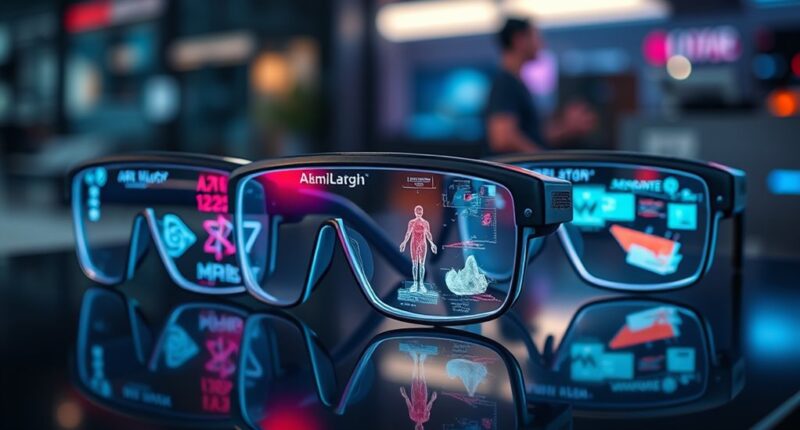If you’re looking for the best AR glasses for immersive experiences in 2025, I recommend the Rokid AR Spatial Glasses, Max2 with Station2, the Rokid Max 2 AR Glasses with its impressive Micro-OLED display, and VILINE Smart Glasses designed for gaming and video. These options combine vibrant visuals, lightweight comfort, and seamless connectivity for a truly immersive experience. Stay tuned—if you continue exploring, you’ll discover which one suits your needs best.
Key Takeaways
- The top AR glasses in 2025 feature high-resolution 360″ Micro-OLED displays with 120Hz refresh rates for crisp, smooth visuals.
- They prioritize comfort with lightweight designs, adjustable fit, and long-term ergonomic support for extended immersive use.
- Compatibility with various devices like smartphones, PCs, and gaming consoles ensures seamless connectivity and streaming.
- Multi-tasking modes and wide FOV (50° or more) enhance productivity, gaming, and entertainment experiences.
- Advanced features such as AI, translation, built-in cameras, and customizable display modes elevate overall immersion.
Rokid AR Spatial Glasses, Max2 with Station2

If you’re looking for AR glasses that blend high-quality visuals with versatile multitasking, the Rokid AR Spatial Glasses Max2 with Station2 is an excellent choice. I love how the 360″ Micro-OLED three-screen display delivers crisp, cinematic visuals with vivid colors and a 120Hz refresh rate, making everything feel smooth and immersive. The unique multi-tasking modes let me run three apps simultaneously, boosting productivity and entertainment. Weighing just 75 grams, they’re comfortable for long wear, and the adjustable IPD and myopia support make them customizable. Plus, the Station2 hub adds powerful connectivity, battery life, and controls, making this set a standout for work, gaming, and media in 2025.
Best For: tech enthusiasts and professionals seeking high-quality AR glasses for multitasking, immersive entertainment, and gaming in 2025.
Pros:
- Crisp, cinematic visuals with vivid colors and high resolution thanks to the 360″ Micro-OLED display and 120Hz refresh rate.
- Versatile multi-tasking with support for three simultaneous apps and adjustable smart modes for varied use cases.
- Lightweight design (75 grams) with customizable features like adjustable IPD and myopia support for comfortable long-term wear.
Cons:
- Lacks camera and AI translation functions, limiting certain interactive applications.
- Some apps, such as File Assistant, may have limited support or functionality in specific modes.
- Requires the Station2 hub for full connectivity and app access, adding extra hardware.
Rokid Max 2 AR Glasses with Micro-OLED Display

The Rokid Max 2 AR Glasses stand out as an excellent choice for users seeking an immersive visual experience without the hassle of internal batteries or complex setup. They feature a 215-inch virtual screen at six meters, thanks to advanced Micro OLED displays delivering sharp, high-contrast visuals. With a 50° wide field of view and a 120Hz refresh rate, visuals feel incredibly smooth and realistic. The adjustable brightness up to 600 nits ensures vivid images, and seamless streaming is supported via HDCP. Powered through USB-C from compatible devices, they’re lightweight at just 75 grams, with adjustable nose pads and myopia correction up to 600 diopters for comfortable, personalized wear.
Best For: users seeking an immersive, high-quality AR experience that is lightweight, easy to connect, and customizable with prescription lenses.
Pros:
- Ultra-lightweight design at only 75 grams for comfortable extended wear
- Sharp 215-inch virtual display with high contrast and wide 50° FOV for immersive visuals
- No internal batteries needed, drawing power directly from connected devices for hassle-free use
Cons:
- Limited to myopia correction up to 600 diopters; other prescriptions require custom lenses
- Does not support astigmatism or presbyopia correction directly within the device
- Compatibility depends on device support for USB-C and screen mirroring, which may vary
VILINE Smart Glasses for Gaming and Video Display

VILINE Smart Glasses stand out for their stunning display quality, making them an excellent choice for gamers and video enthusiasts seeking immersive experiences. With a 50° FOV and ultra-sharp 1920×1080 OLED screens, they deliver clear visuals with minimal distortion. The peak brightness of 400 nits, perceived brightness over 1500 nits, and up to 1800 nits for comfort ensure vivid images even in bright environments. They’re calibrated for color accuracy, providing a personal theater experience at home. Lightweight at 79 grams, with adjustable diopters and blue light reduction, these glasses promise all-day comfort, making long gaming or video sessions truly enjoyable.
Best For: gamers and video enthusiasts seeking immersive, high-quality visual experiences with eye comfort for long sessions.
Pros:
- Ultra-sharp 1920×1080 OLED display with 50° FOV ensures clear, vivid visuals at edges without distortion
- Brightness up to 1800 nits provides excellent visibility in bright environments, reducing eye strain
- Lightweight (79g) design with adjustable diopters and eye-care features for all-day comfort
Cons:
- Compatibility may require adapters for some gaming consoles and certain smartphones depending on protocols
- Requires USB-C connection, which could limit use with devices lacking compatible ports
- As a relatively new product, ongoing ecosystem support and user community are still developing
Factors to Consider When Choosing AR Glasses for Immersive Experiences

When choosing AR glasses for immersive experiences, I focus on display quality and comfort first, since these impact how long I can enjoy them. Compatibility with other devices and useful features also matter to guarantee smooth integration and enhanced visuals. Ultimately, I consider power, connectivity, and modes to keep the experience seamless and versatile.
Display Quality and Clarity
To achieve truly immersive experiences with AR glasses, display quality and clarity are essential factors to take into account. High resolution and pixel density are indispensable for sharp, realistic images, minimizing pixelation and making virtual elements seamlessly blend with the real world. A wide field of view (FOV) enhances immersion by expanding the virtual environment around your peripheral vision, creating a more natural experience. Brightness levels of 600 nits or higher ensure visibility in various lighting conditions, including outdoors. Support for high refresh rates, like 120Hz, provides smooth motion and reduces latency, which is critical during fast-paced interactions. Accurate color reproduction and high contrast ratios further improve visual vividness, helping virtual elements stand out clearly and convincingly against real-world backgrounds.
Comfort and Fit
Ensuring a comfortable fit is essential for fully immersing yourself in AR experiences, especially during extended use. A well-fitting pair of AR glasses prevents fatigue and discomfort by reducing unnecessary pressure on your face. Look for adjustable nose pads and temple arms, which allow you to customize the fit for your head shape. Lightweight glasses, ideally under 100 grams, help minimize strain on your neck and head, making long sessions more comfortable. Soft, flexible materials for the temples and nose pads can reduce pressure points and skin irritation. A secure fit that stays in place during movement ensures consistent immersion without distractions. Proper balance and alignment also help prevent eye strain and visual distortion, so you can enjoy extended, immersive AR experiences comfortably.
Compatibility With Devices
Choosing AR glasses that seamlessly connect with your devices is essential for an immersive experience. You need to guarantee they’re compatible with your primary devices, whether it’s a smartphone, PC, gaming console, or tablet. Check the supported connection types like USB-C, Bluetooth, or Wi-Fi to match your device’s ports and wireless capabilities. It’s also important to verify if the glasses support screen mirroring or streaming protocols, such as HDCP or specific display standards your devices use. Make sure they’re compatible with your device’s operating system—Android, iOS, Windows, or macOS—to avoid functionality issues. Additionally, consider whether the glasses support any necessary adapters or accessories for your setup, especially if you plan to connect them to gaming consoles or specialized equipment.
Visual Features & Modes
When evaluating AR glasses for immersive experiences, visual features and display modes play a pivotal role in how you perceive digital content. High-resolution displays, like Micro-OLED or OLED, deliver sharp images with excellent contrast, making visuals more vivid and realistic. It’s crucial to consider display modes such as multi-screen, giant screen, or sports mode, which enhance multitasking and entertainment by tailoring the visuals to different activities. A wider field of view, ideally 50° or more, creates a more natural, expansive experience that mimics real-world depth. Brightness levels up to 600 nits ensure clarity even in bright environments, while compatibility with various content formats and standards like HDCP guarantees seamless streaming and high-quality viewing. These features greatly influence immersion and overall satisfaction.
Power and Connectivity
To get the most out of your AR glasses during immersive experiences, you need reliable power and connectivity options. Make sure they support seamless connectivity methods like USB-C, Bluetooth, or Wi-Fi for quick data transfer and easy device pairing. Check if the glasses draw power from your connected device or have their own internal batteries, as this affects portability and usage time. Compatibility is vital—ensure they work smoothly with your smartphones, PCs, gaming consoles, or tablets. Also, look for features like screen mirroring or direct device connection to reduce latency and enhance immersion. Finally, review their power requirements and charging methods, especially if you plan to wear them for extended periods. Reliable power and connectivity are essential for uninterrupted, immersive experiences.
Additional Features and Limitations
Additional features can considerably enhance your immersive experience, but they may also introduce limitations. For example, built-in cameras, AI functions, translation tools, or interactive apps can make your interactions more engaging and versatile. However, they might also restrict app support or lock you into fixed viewing modes, reducing flexibility. Compatibility with streaming platforms and seamless content sharing are crucial for maximizing entertainment options, so check if the glasses support these features. Adjustable settings like field of view, brightness, or myopia correction help personalize your experience, but hardware constraints such as weight, comfort, and battery life can affect prolonged use. Balancing these features and limitations ensures you choose AR glasses that deliver immersive content without sacrificing usability or comfort.
Frequently Asked Questions
How Do AR Glasses Impact Long-Term Eye Health?
AR glasses can impact long-term eye health if used improperly. I’ve found that extended use might cause eye strain, dry eyes, or headaches due to focusing on close screens for too long. To protect my eyes, I take regular breaks, adjust brightness levels, and make sure proper fit. Staying mindful of my eye comfort helps prevent potential issues and keeps my experience enjoyable without long-term harm.
ARe AR Glasses Suitable for Outdoor Use in Bright Sunlight?
Like a lighthouse in a storm, AR glasses can shine outdoors, but bright sunlight still poses challenges. I find that many models have reflective or anti-glare coatings that help, yet visibility can still be compromised in direct sunlight. If you’re planning heavy outdoor use, look for glasses with high luminance and good contrast. They’re suitable, but don’t expect perfect clarity everywhere—some glare is inevitable.
What Is the Battery Life of These AR Glasses During Extended Use?
The battery life of these AR glasses varies depending on the model, but generally, I find it lasts around 4 to 8 hours with continuous use. I always carry a portable charger for extended sessions, especially during outdoor activities or long workdays. Keep in mind that heavy usage like gaming or streaming can drain the battery faster. Overall, I recommend choosing a model with longer battery life if you need all-day performance.
Can AR Glasses Be Customized for Different Head Sizes and Shapes?
Imagine your AR glasses fitting like a tailored suit, hugging your head perfectly. Yes, many models now offer customizable options for different head sizes and shapes, ensuring comfort and stability. Adjustable straps, interchangeable padding, and modular designs help create a snug fit, so you can immerse yourself without distraction. It’s like the glasses were made just for you, turning tech into a seamless extension of yourself.
How Secure Is Data Privacy When Using AR Glasses for Immersive Experiences?
I believe data privacy with AR glasses depends heavily on the manufacturer and how users handle their settings. I always make sure I review privacy policies and adjust permissions to limit data sharing. While some devices have robust security measures, no system is entirely foolproof. So, I stay cautious, avoid sharing sensitive info, and keep software updated to minimize risks and protect my personal data during immersive experiences.
Conclusion
Choosing the right AR glasses is like finding the perfect pair of shoes—you want comfort, style, and performance all in one. Whether it’s the Rokid Max2’s stunning display or VILINE’s gaming prowess, each offers unique advantages. Remember, the best AR glasses for you are the ones that seamlessly blend into your world, turning the ordinary into extraordinary. Immerse yourself, explore, and let your immersive journey begin—because these glasses are your gateway to a new reality.









